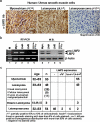Potential role of LMP2 as tumor-suppressor defines new targets for uterine leiomyosarcoma therapy
- PMID: 22355695
- PMCID: PMC3240965
- DOI: 10.1038/srep00180
Potential role of LMP2 as tumor-suppressor defines new targets for uterine leiomyosarcoma therapy
Abstract
Although the majority of smooth muscle neoplasms found in the uterus are benign, uterine leiomyosarcoma (LMS) is extremely malignant, with high rates of recurrence and metastasis. We earlier reported that mice with a homozygous deficiency for LMP2, an interferon (IFN)-γ-inducible factor, spontaneously develop uterine LMS. The IFN-γ pathway is important for control of tumor growth and invasion and has been implicated in several cancers. In this study, experiments with human and mouse uterine tissues revealed a defective LMP2 expression in human uterine LMS that was traced to the IFN-γ pathway and the specific effect of JAK-1 somatic mutations on the LMP2 transcriptional activation. Furthermore, analysis of a human uterine LMS cell line clarified the biological significance of LMP2 in malignant myometrium transformation and cell cycle, thus implicating LMP2 as an anti-tumorigenic candidate. This role of LMP2 as a tumor suppressor may lead to new therapeutic targets in human uterine LMS.
Figures




Similar articles
-
Uterine Leiomyosarcoma Tumorigenesis in Lmp2-deficient Mice: Involvement of Impaired Anti-oncogenic Factor IRF1.Anticancer Res. 2015 Sep;35(9):4665-79. Anticancer Res. 2015. PMID: 26254356
-
Potential role of LMP2 as an anti-oncogenic factor in human uterine leiomyosarcoma: morphological significance of calponin h1.FEBS Lett. 2012 Jun 21;586(13):1824-31. doi: 10.1016/j.febslet.2012.05.029. Epub 2012 May 29. FEBS Lett. 2012. PMID: 22659265
-
Mice-lacking LMP2, immuno-proteasome subunit, as an animal model of spontaneous uterine leiomyosarcoma.Protein Cell. 2010 Aug;1(8):711-7. doi: 10.1007/s13238-010-0095-x. Epub 2010 Aug 28. Protein Cell. 2010. PMID: 21203912 Free PMC article. Review.
-
Potential diagnostic biomarkers: differential expression of LMP2/β1i and cyclin B1 in human uterine leiomyosarcoma.Tumori. 2014 Jul-Aug;100(4):99e-106e. doi: 10.1700/1636.17918. Tumori. 2014. PMID: 25296613
-
Molecular Pathology and Novel Clinical Therapy for Uterine Leiomyosarcoma.Anticancer Res. 2016 Oct;36(10):4997-5007. doi: 10.21873/anticanres.11068. Anticancer Res. 2016. PMID: 27798858 Review.
Cited by
-
Two-Dimensional-PAGE Coupled with nLC-MS/MS-Based Identification of Differentially Expressed Proteins and Tumorigenic Pathways in MCF7 Breast Cancer Cells Transfected for JTB Protein Silencing.Molecules. 2023 Nov 9;28(22):7501. doi: 10.3390/molecules28227501. Molecules. 2023. PMID: 38005222 Free PMC article.
-
Characteristic of Uterine Rhabdomyosarcoma by Algorithm of Potential Biomarkers for Uterine Mesenchymal Tumor.Curr Oncol. 2022 Mar 28;29(4):2350-2363. doi: 10.3390/curroncol29040190. Curr Oncol. 2022. PMID: 35448164 Free PMC article.
-
Osterix promotes the migration and angiogenesis of breast cancer by upregulation of S100A4 expression.J Cell Mol Med. 2019 Feb;23(2):1116-1127. doi: 10.1111/jcmm.14012. Epub 2018 Nov 18. J Cell Mol Med. 2019. PMID: 30450809 Free PMC article.
-
JAK1 truncating mutations in gynecologic cancer define new role of cancer-associated protein tyrosine kinase aberrations.Sci Rep. 2013 Oct 24;3:3042. doi: 10.1038/srep03042. Sci Rep. 2013. PMID: 24154688 Free PMC article.
-
The Novel HDAC Inhibitor OBP-801 Promotes MHC Class I Presentation Through LMP2 Upregulation, Enhancing the PD-1-Targeting Therapy in Clear Cell Renal Cell Carcinoma.Cancers (Basel). 2024 Dec 4;16(23):4058. doi: 10.3390/cancers16234058. Cancers (Basel). 2024. PMID: 39682244 Free PMC article.
References
-
- Zaloudek C. & Hendrickson M. R. Mesenchymal tumors of the uterus, in Kurman RJ. (ed): Blaustein's Pathology of the Female Genital Tract (ed 5). New York, Springer-Verlag 561–578 (2002).
-
- Gadducci A., et al. Uterine leiomyosarcoma: analysis of treatment failures and survival. Gynecol. Oncol. 62, 25–32 (1996). - PubMed
-
- Nordal R. & Thoresen S. Uterine sarcomas in Norway 1956–1992: incidence, survival and mortality. Eur. J. Cancer 33, 907–311 (1997). - PubMed
-
- Brooks S. E., Zhan M., Cote T. & Baquet C. R. Surveillance, epidemiology, and end results analysis of 2677 cases of uterine sarcoma 1989–1999. Gynecol. Oncol. 93, 204–208 (2004). - PubMed
-
- Dusenbery K. E., Potish R. A., Argenta P. A. & Judson P. L. On the apparent failure of adjuvant pelvic radiotherapy to improve survival for women with uterine sarcomas confined to the uterus. Am. J. Clin. Oncol. 28, 295–300 (2005). - PubMed
Publication types
MeSH terms
Substances
LinkOut - more resources
Full Text Sources
Other Literature Sources
Medical
Molecular Biology Databases
Research Materials
Miscellaneous

